Chinelos are more than just traditional Mexican dancers. They embody a rich cultural heritage, vibrant energy, and captivating symbolism that mesmerizes onlookers. These dancers, adorned in colorful costumes and intricate masks, take center stage in festivals and celebrations across Mexico. With each step, the chinelos tell a story of tradition, community, and pride. Join us on a journey to explore the enchanting world of chinelos and uncover the secrets hidden behind their rhythmic movements.
Discovering the Magical World of Chinelos
Welcome, young explorers! Today, we are diving into the fascinating universe of Chinelos. Have you ever heard of these colorful and lively characters? If not, get ready to embark on a journey filled with music, dance, and vibrant traditions. Let’s uncover the enchanting world of Chinelos together!
What are Chinelos?
Chinelos are traditional Mexican dancers known for their elaborate costumes and masks. These performers are an integral part of festivals and celebrations, bringing joy and entertainment to communities across Mexico. The word “Chinelo” originates from the Nahuatl language, meaning “disguised person.”
One of the most striking features of Chinelos is their unique attire. They wear colorful, oversized costumes adorned with sequins, ribbons, and intricate designs. The masks they don often depict exaggerated facial expressions, adding a touch of mystery and playfulness to their performances.
The History of Chinelos
To truly appreciate the art of Chinelos, we must delve into their rich history. The tradition of Chinelos dates back to the 19th century in the state of Morelos, Mexico. Initially, Chinelos served as a form of protest against the Spanish colonial authorities, allowing indigenous communities to express themselves through dance and music.
Over time, Chinelos evolved into a symbol of resistance and cultural pride. Today, these dancers are revered for their ability to preserve age-old traditions while adapting to modern influences. The spirited rhythms of Chinelos music and the energetic movements of the dancers continue to captivate audiences worldwide.
The Dance of Joy
At the heart of Chinelos performances is the energetic and lively dance that embodies the spirit of celebration. The dancers move in sync to the rhythmic beats of drums and other traditional instruments, creating a spectacle that is both visually stunning and emotionally uplifting.
As you watch the Chinelos dance, you will witness a burst of colors swirling around the performers, as if each movement tells a story of resilience and joy. The infectious energy of the dancers is sure to inspire you to join in the festivities and celebrate life’s moments, big or small.
The Symbolism of Chinelos
Beyond the dazzling costumes and lively dances, Chinelos carry deep symbolism that reflects Mexican culture and heritage. The masks worn by the dancers symbolize a transformation from everyday life to a realm of magic and enchantment.
Chinelos also represent a sense of unity and community. Through their performances, they bring people together, transcending barriers of age, gender, and background. The inclusive nature of Chinelos celebrations fosters a sense of belonging and camaraderie among all who participate.
Joining the Chinelos Celebration
Now that you’ve learned about the captivating world of Chinelos, perhaps you’re eager to experience it for yourself. You don’t have to travel all the way to Mexico to join in the festivities – you can create your own Chinelos-inspired celebration right at home!
Gather your friends and family, put on your most festive attire, and crank up the music. Immerse yourself in the vibrant rhythms and colorful traditions of Chinelos as you dance and laugh together. Let the spirit of Chinelos infuse your gathering with joy and positivity.
As we wrap up our exploration of Chinelos, remember that the magic of these traditional dancers lies not only in their colorful costumes and lively dances but also in the profound cultural significance they carry. Through the art of Chinelos, we connect with the past, celebrate the present, and look forward to a future filled with unity and resilience.
So, the next time you hear the rhythmic beats of Chinelos music or see the vibrant colors of their costumes, pause for a moment and appreciate the beauty and spirit of this cherished tradition. Let the world of Chinelos inspire you to dance through life with joy and exuberance!
Chinelos de Morelos en el Desfile 5 de Mayo New York City-Cinco de Mayo Parade NYC
Frequently Asked Questions
What are chinelos and their significance in Mexican culture?
Chinelos are traditional Mexican dancers characterized by their colorful costumes, masks, and energetic performances. They play a significant role in festivals, especially during Carnaval, as they represent a form of rebellion against the Spanish colonizers.
How are chinelos typically dressed during performances?
Chinelos wear elaborate costumes consisting of colorful robes, ornate masks, large hats adorned with feathers, and jangling beaded necklaces. The outfits are designed to be eye-catching and vibrant to captivate the audience during their lively dances.
What is the origin of the chinelos tradition?
The tradition of chinelos dates back to the 19th century in Mexico, particularly in the state of Morelos. It is said to have originated as a form of satire against the Spanish elite, with dancers adopting exaggerated mannerisms and donning masks to mock the aristocracy.
How do chinelos contribute to cultural preservation in Mexico?
Chinelos play a vital role in preserving Mexican heritage and traditions by showcasing their unique dance style and attire at various cultural events and celebrations. Through their performances, they help keep alive the history and spirit of resistance that underpins their tradition.
Final Thoughts
Chinelos, a traditional Mexican dance characterized by colorful costumes and rhythmic movements, captivates both participants and spectators. This vibrant cultural expression showcases a blend of indigenous and Spanish influences, celebrating community and festivity. Through elaborate masks and intricate footwork, chinelos embody a rich history of heritage and storytelling. Engaging in this lively dance form not only entertains but also preserves Mexico’s cultural identity for future generations to cherish.




